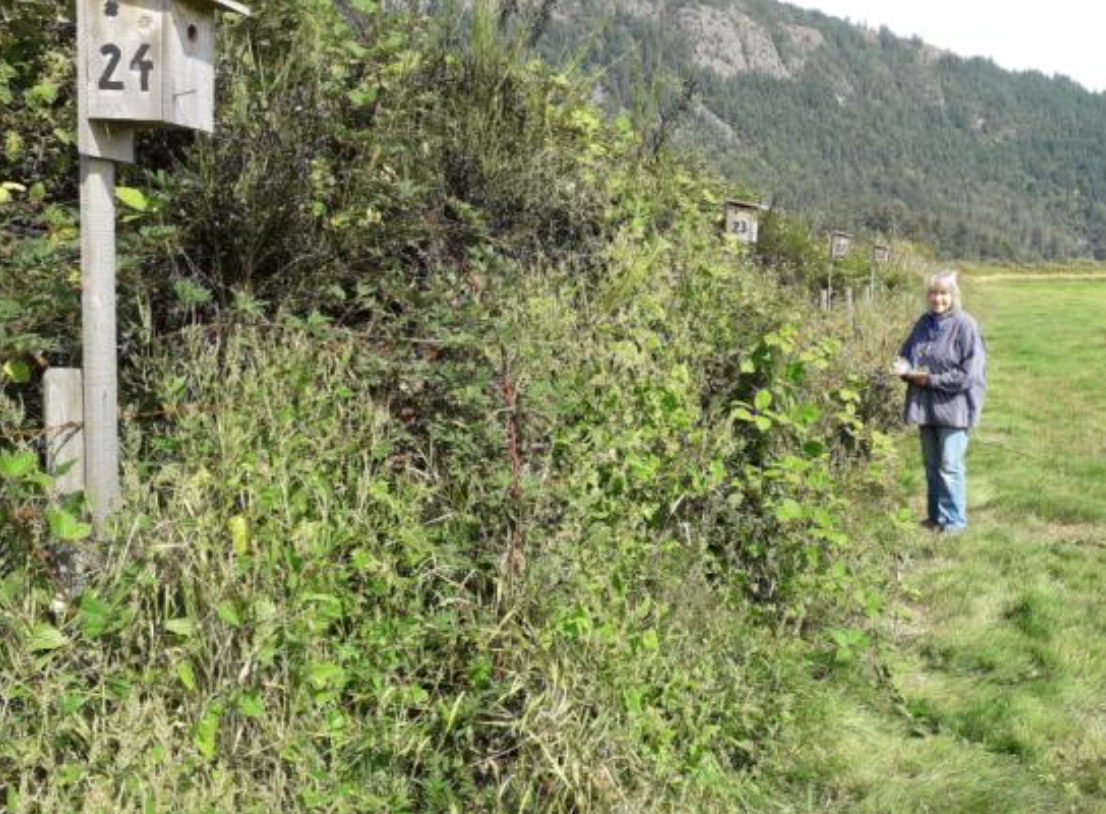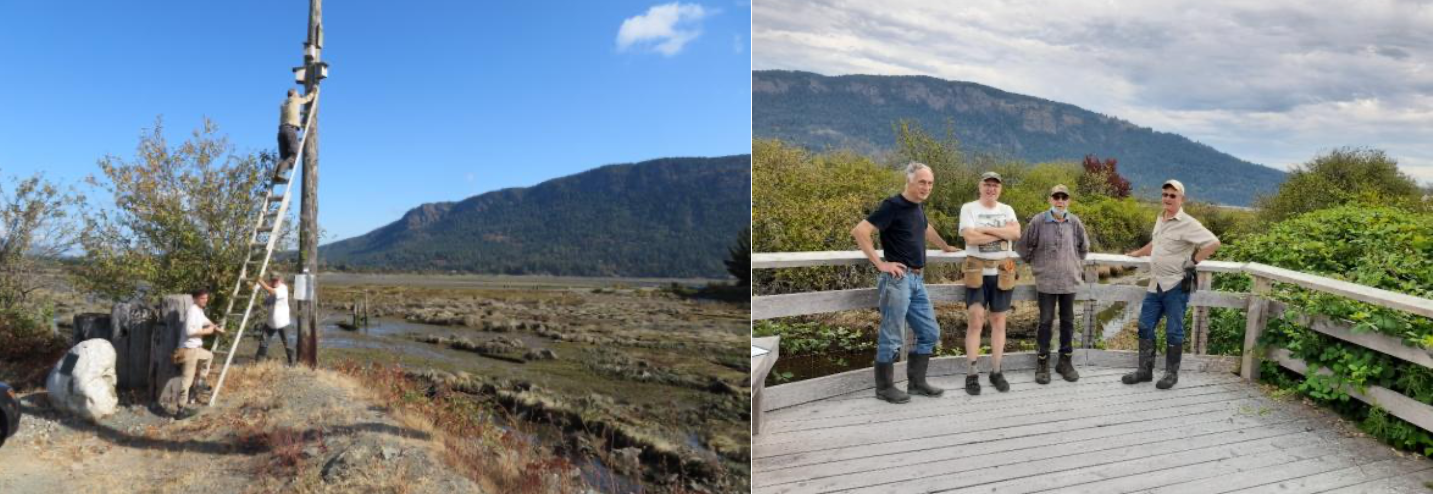Tree Swallow Project 2022
Tree Swallow Monitoring 2022
South Fork and Hydro-poles: As in the past six years, the cleaning of the bird boxes took place at the end of August. Of the forty bird boxes placed along the South Fork of the Cowichan River and adjacent salt marsh, 83% were occupied with completed nets, feces, and other indicators of successful hatching. Five boxes were empty and two with unfinished nests. We encountered two boxes with two dead fledglings each, one box with three and another one with one dead fledgling; five nests with one un-hatched egg, and another with two. Of the four hydro-poles with eight boxes total, four successful occupancies, two empty boxes, and two unfinished nests.
Forty intact boxes remain along the Cowichan River South Fork and the three hydro- poles. Of the 45 boxes originally placed in this location, 5 boxes have disappeared.
The nest box occupancy at this location was 93% in 2020 compared to a mere 38% in 2021. In 2021 we found 10 boxes with fully feathered fledglings; 25 dead birds in total and five un-hatched eggs compared to two boxes with a total of 4 dead birds and 8 nests with a total of 11 un-hatched eggs in 2020. We hypothesized that the poor results in 2021 and the high number of dead bodies and un-hatched eggs were related to an early spring in 2021 with an early arrival by the birds, resulting in an earlier than usual breeding season which coincided with a heat wave causing extreme temperatures day and night. This resulted in overheated nest boxes. The high juvenile mortality may have been caused by dehydration. In 2022 we experienced an unusual wet and late spring followed by a relatively normal summer. It may therefore be assumed that major prey species of swallows were available at the right time after hatching, contributing to a
significant population increase during a successful breeding season.
Heritage House Salt-marsh:
Judging by the indicators, of the 23 boxes hung along the fence-line of the heritage house only 35% were successfully occupied. Fifteen boxes remained empty. One nest with one egg and two nests with one fledgling each were found. The results are similarly poor as in the previous year. We are contemplating relocating all 23 boxes, moving them into the more open terrain of the salt marsh. This option will have to be discussed with the owners of the heritage house who also own the adjacent salt marsh meadow. It appears that swallows may avoid boxes close to dense shrub vegetation which provides ideal hunting conditions for predators, a hypothesis still to be proven (see photo).
Just like last year we found one nest completely built of moss compared to the most common nest material usually composed of grass and feathers.
Compared to the nest box occupancy of 12% in 2020 and 29% in 2021, 35% successful box occupancy in 2022 appears to be an improvement; however, the results
are not considered good enough to justify keeping the boxes at the current location.
The number of dead fledglings and one dead adult found inside the seven boxes in 2020 was shocking. In one nest the entire clutch appeared to have been wiped out, five fully feathered birds dead! And one more dead fledglings in another nest; and one dead adult in a third nest. In comparison, no dead birds but five un-hatched eggs were encountered on this site in 2020, and only 2 dead birds and 1 egg in 2022.
Blackley's Farm: Of the 27 boxes placed along the fence line adjacent to the dyke trail, only six boxes were found occupied. Eighteen boxes stayed empty, three showed uncompleted nests. The results at this location echo the results of the heritage location. Again, the boxes are located very close to the dense shrub growth along the dyke trail on one side, canary grass growing right up to the boxes on the meadow side and a corn field established parallel to the fence as shown in the photo below with Beate pointing at the dead adult swallow found in one nest. The photo to the right from 2020 shows the still intact meadow in front of the boxes converted by the new owner in 2021 into a cornfield.
Compared to nest box occupancy of 18% in 2020 and 37% in 2021, this year's result of only 22% successful occupancy is very disappointing. We had expected a much higher occupancy rate for 2022 with birds raised at this location in previous years returning. The conditions seemed to be favourable for a higher box occupancy. But with the corn planted in front, the conditions have changed for the worse. We also may have to relocate the boxes moving them into a more open space pending permission by the new owners of the farm we would like to attach them to posts to be placed alongside the drainage channel in the center of the upper unused meadow.
In 2021 we found 2 boxes with 3 dead, fully feathered fledglings, and two un-hatched eggs. A surprising 4 boxes showed half-finished nests. In 2022 there were no dead fledglings or un-hatched eggs in any nest.
I would like to take this opportunity to thank this year's swallow volunteer team. From left to the right on the right photo: Bob Down, John Shaw, Peter Scheiler, and Bill Lawrance (and Goetz) This year's hero: Bill Lawrance climbing the flimsy ladder leaning against the hydro-pole by the breach in the dyke with three boxes to clean at the top of the pole while shaking in his boots! Well done, Bill! Who experienced it once, thinks twice about it the next time as Bob Down can tell who climbed up there last year as shown in the left photo. Thanks also to my wife Beate Weber-Schuerholz who helped me check the boxes at former Blackley's farm, as she did already last year.
Assessing the overall success of this swallow habitat enhancement project, we may proudly say that our work does make a difference, even in a bad year. This year 47 boxes had nests with conclusive indicators of successfully producing one healthy clutch each. On average a tree swallow pair produces 4 to 5 eggs per nest, resulting in 188 to 235 eggs for the 47 occupied boxes in 2022. A very conservative estimate of 3 fledglings successfully reaching adulthood (taking the number of un-hatched eggs and dead fledglings into account), a total of 141 birds have been added to the local swallow population, a result we can be proud of!
Goetz Schuerholz, Chair CERCA








